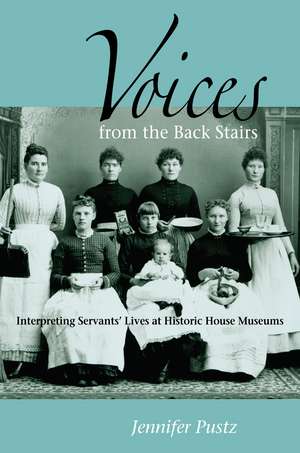Voices from the Back Stairs: Interpreting Servants' Lives at Historic House Museums
Autor Jennifer Pustzen Limba Engleză Paperback – 14 oct 2009
Historic house museums—one of the most prevalent types of history museums in the country—have long depicted the owners of the house and their families, but representing the servants has introduced a unique set of challenges. While museum professionals have increasingly incorporated women, immigrants, African Americans, and other minorities into portrayals of the past, these portrayals often show an idealistic world without class antagonisms or ethnic conflict. Exploring the domestic conflicts that may have existed between mistress and servant often creates a more vivid and believable experience for guests.
Through her examination of the pitfalls of interpretation, Pustz offers advice for museum professionals on programming accurate and compelling depictions of those who lived their lives in the back stairs and kitchen rather than in the parlor. Based on extensive surveys of historians at historic house museums, this informative study presents examples of successful interpretation programs, including those that have made the kitchen and servants’ quarters the most popular stops on the tour. Pustz encourages museum curators to look beyond the archives of their own institution and explore other era-appropriate sources, including advertising and housekeeping guides, when trying to create a complete picture of the house’s servants, who often left behind few records.
Through her examination of the pitfalls of interpretation, Pustz offers advice for museum professionals on programming accurate and compelling depictions of those who lived their lives in the back stairs and kitchen rather than in the parlor. Based on extensive surveys of historians at historic house museums, this informative study presents examples of successful interpretation programs, including those that have made the kitchen and servants’ quarters the most popular stops on the tour. Pustz encourages museum curators to look beyond the archives of their own institution and explore other era-appropriate sources, including advertising and housekeeping guides, when trying to create a complete picture of the house’s servants, who often left behind few records.
Preț: 265.92 lei
Nou
Puncte Express: 399
Preț estimativ în valută:
50.89€ • 55.26$ • 42.75£
50.89€ • 55.26$ • 42.75£
Carte tipărită la comandă
Livrare economică 23 aprilie-07 mai
Preluare comenzi: 021 569.72.76
Specificații
ISBN-13: 9780875806228
ISBN-10: 0875806228
Pagini: 250
Dimensiuni: 152 x 229 x 20 mm
Greutate: 0.36 kg
Ediția:1
Editura: Northern Illinois University Press
Colecția Northern Illinois University Press
ISBN-10: 0875806228
Pagini: 250
Dimensiuni: 152 x 229 x 20 mm
Greutate: 0.36 kg
Ediția:1
Editura: Northern Illinois University Press
Colecția Northern Illinois University Press
Recenzii
“Voices from the Back Stairs will be a great benefit to curators and educators who work at historic sites. It not only provides the latest scholarship on domestic servants but many practical techniques for improving the interpretation of their work and lives.”—Max van Balgooy, Director of Interpretation and Education, National Trust for Historic Preservation
Notă biografică
Jennifer Pustz holds a Ph.D. in American studies from the University of Iowa and has worked as a historian in historic house museums for more than a decade. She is the museum historian at Historic New England where she conducts and presents research for the organization and its historic sites.
Cuprins
Contents
Acknowledgments
Introduction
Chapter 1. Shrines, Slave Quarters, and Social Relevance: The Changing Historic House Museum
Chapter 2. Interpretation of Domestic Service at Post–Civil War House Museums
Chapter 3. The Ideal, the Real, and the Servant Problem
Photo Essay I: The Servant Problem Illustrated
Chapter 4. Using the Servant Problem to Interpret Domestic Life
Chapter 5. Case Studies in Domestic Service Interpretation
Photo Essay II: Contemporary Interpretations
Appendix 1. Text of Mail Questionnaire Sent to Historic House Museums
Appendix 2. Additional Resources
Notes
Works Cited
Index
Introduction
Chapter 1. Shrines, Slave Quarters, and Social Relevance: The Changing Historic House Museum
Chapter 2. Interpretation of Domestic Service at Post–Civil War House Museums
Chapter 3. The Ideal, the Real, and the Servant Problem
Photo Essay I: The Servant Problem Illustrated
Chapter 4. Using the Servant Problem to Interpret Domestic Life
Chapter 5. Case Studies in Domestic Service Interpretation
Photo Essay II: Contemporary Interpretations
Appendix 1. Text of Mail Questionnaire Sent to Historic House Museums
Appendix 2. Additional Resources
Notes
Works Cited
Index
Descriere
Historic house museums—one of the most prevalent types of history museums in the country—have long depicted the owners of the house and their families, but representing the servants has introduced a unique set of challenges. While museum professionals have increasingly incorporated women, immigrants, African Americans, and other minorities into portrayals of the past, these portrayals often show an idealistic world without class antagonisms or ethnic conflict. Exploring the domestic conflicts that may have existed between mistress and servant often creates a more vivid and believable experience for guests.
Through her examination of the pitfalls of interpretation, Pustz offers advice for museum professionals on programming accurate and compelling depictions of those who lived their lives in the back stairs and kitchen rather than in the parlor. Based on extensive surveys of historians at historic house museums, this informative study presents examples of successful interpretation programs, including those that have made the kitchen and servants’ quarters the most popular stops on the tour. Pustz encourages museum curators to look beyond the archives of their own institution and explore other era-appropriate sources, including advertising and housekeeping guides, when trying to create a complete picture of the house’s servants, who often left behind few records.
Through her examination of the pitfalls of interpretation, Pustz offers advice for museum professionals on programming accurate and compelling depictions of those who lived their lives in the back stairs and kitchen rather than in the parlor. Based on extensive surveys of historians at historic house museums, this informative study presents examples of successful interpretation programs, including those that have made the kitchen and servants’ quarters the most popular stops on the tour. Pustz encourages museum curators to look beyond the archives of their own institution and explore other era-appropriate sources, including advertising and housekeeping guides, when trying to create a complete picture of the house’s servants, who often left behind few records.









